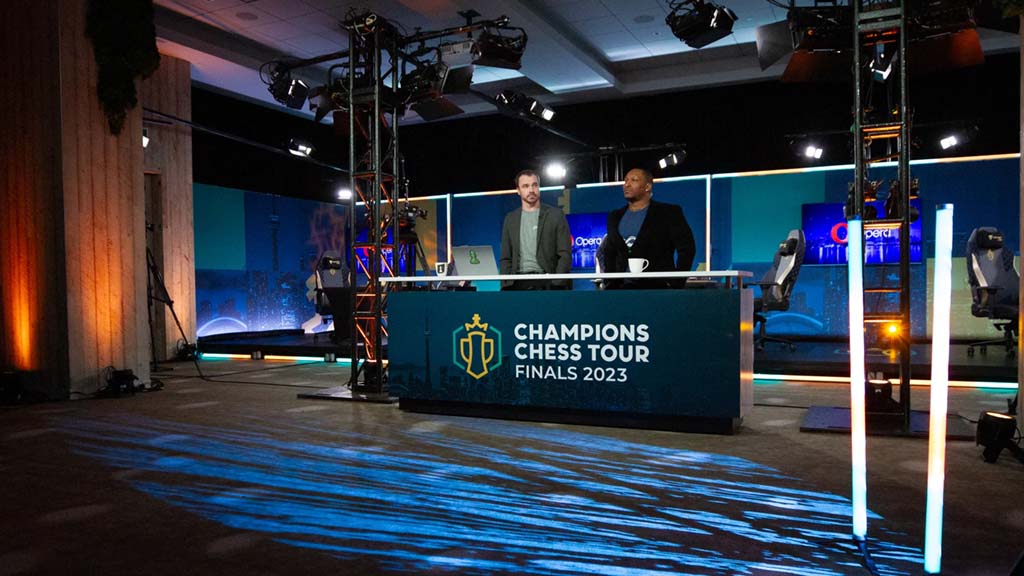Chess.com Builds a New Remote Production System With Vizrt and NDI
Like the game it follows, producing content for the gaming platform requires strategic thinking

PALO ALTO, Calif.—Chess is a unique game, and the reasons why people become interested in it are varied. Much like other games, it requires skill, attention, and strategic thinking. But the length of a match is never the same and the longer it is, the longer the tension builds. For a viewer, catching every second counts. Especially if they’re tuning in virtually.
At Chess.com, we have a loyal, international, growing community of chess enthusiasts, currently producing for 150 million users and counting. Chess.com consistently delivers more than 300 productions annually, encompassing live tournaments, interviews, instructional content and community events.
Because we want to make chess available to everyone—and the demand keeps increasing—investing in a higher-quality production is the natural next step. From the basic OBS setups we were using to keep up with the increasing demand, we decided to create a completely remote broadcasting solution that lives entirely in the cloud.
At first, the idea was to build a physical studio, but that was quickly scratched—since we are a fully remote company, it made the most sense to create a fully remote broadcasting solution. This meant we wouldn’t be tied to physical constraints and every member of the production team would be able to access whatever they needed for the productions.
Our Virtual Truck
Working closely with teams at Vizrt, NDI and ecosystem partner Advanced Systems Group (ASG), the answer came in the form of a “virtual production truck,” with a setup that uses Vizrt’s TriCaster Vectar and NDI technology at its core, hosted on Amazon Web Services (AWS), with Viz Flowics providing HTML5 graphics.

We looked at just about every single vision mixer available in the cloud, and ultimately landed on TriCaster Vectar as the tool that best supported our needs. We needed to be able to ingest a hefty number of inputs while also being able to support a wide range of production models. TriCaster Vectar enables us to operate both in small crew environments, where the Technical Director wears a lot of hats like audio and video playout, but also to flex up to a larger, fully remote crew where we break those roles away from the switcher.
With TriCaster Vectar’s native ability to incorporate high-quality HTML5 graphics, we can add audience comments from different social media platforms, including YouTube Live and Twitch, during live games. It’s crucial for us to let fans share their experiences and reactions, and nurture that sense of community.
The professional video industry's #1 source for news, trends and product and tech information. Sign up below.
HTML5 Graphics
Chess is an incredibly graphics-heavy broadcast, and TriCaster Vectar being able to bring in HTML5 graphics without consuming the available NDI inputs was also a big win for us. We regularly use between eight and 10 animation buffers as our production graphics channels; it’s basically become 10 additional inputs strictly for graphics and allows us to fully max out the 44 inputs for cameras and video playback on larger productions.
It took just about a month and a half to put together the virtual production truck. I know it sounds insane, but we connected everything through cloud-based software, while leveraging the flexibility of NDI.
This virtual production workflow allows Chess.com’s employees in Europe, South Africa, India, and the United States to have access to all the live production tools they’d expect to see in a traditional studio or broadcasting truck. Telos Infinity VIP provides intercom to 18 physical intercom panels installed in employees’ home offices, as well as offering up to 41 virtual panels so they can seamlessly collaborate despite being fully remote.
With the scalability of this cloud-based system, Chess.com can continue to expand our production capabilities without the need for frequent hardware upgrades, so we can grow as our community grows.
More information is available at vizrt.com, ndi.video and www.asgllc.com.

Mike Buetsch is a seasoned professional with over a decade of experience in gaming and esports live production who joined Chess.com two years ago.
